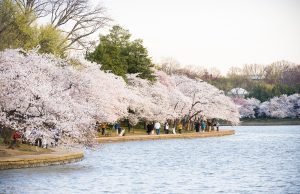Trees Equal Big Value
An Interview with Pete Smith, Arbor Day Foundation program manager, urban forestry
Evoking Childhood Memories
There’s no question that trees offer solutions to the world’s big environmental challenges but they are also tied to many of our memories. Try this exercise Pete Smith recommends.

Close your eyes and picture a tree and its leaves. What does that tree mean to you?
“There are plenty of folks who can see that tree,” Pete Smith, Arbor Day Foundation urban forestry program manager, said during an interview on Feb. 14, 2023.
Chances are there’s a tree or two in your past that evokes fond childhood memories.
For Smith, it was the native Sugar maples and other trees on his street and in his backyard as a child growing up in Philadelphia that led Smith to explore forestry.
“I would challenge anyone to go through that exercise and experience it (that tree) personally,” he said.
As a result, a lot of his work in forestry for the Arbor Day Foundation focuses on sustainable management whether it’s working with private landowners or corporate interests.
“I think they (the trees) certainly inspired me as a young person to look to nature and I never really lost that zeal for urban trees,” Smith said. “Going to Penn State and choosing forestry seemed to be a logical progression.

Inspiring Environmental Advocacy
When you think of the Arbor Day Foundation, there’s no doubt planting trees comes to mind, but in addition, Smith and his team also inspire environmental change by helping to get people around the globe more engaged in understanding the role of trees and why they are an important natural resource. Tree City USA, a long-running Arbor Day Foundation program, for example, provides a four-step framework to maintain and grow tree cover.
According to arborday.org, communities can receive annual Tree City USA recognition by meeting four standards: Maintaining a tree board or department; having a community tree ordinance; spending at least $2 per capita on urban forestry; and celebrating Arbor Day, a tree-planting holiday.
Smith’s work comes with its share of challenges as many cities and communities are experiencing significant growth and are trying to balance the growing need for housing without killing or tearing down trees.
Act Responsibly
Is there a way to do construction that doesn’t require developers to remove trees?
Smith said, yes. “You can actually build around trees…,” and while he believes we still value existing big healthy trees, he utilizes his expertise in urban community forestry to further educate individuals and municipalities about the best practices for preserving trees during construction.
“But how do we act responsibly?” Smith asked.
Despite the cost factor that’s associated with preserving trees, there are communities around the country that are trying their best to deal with the incredible growth of housing and the need for it while keeping some of the trees onsite.
This is where significant growth meets national standards and ordinances that require developers to replant an equivalent number of trees on site.
However, he cautioned, “That’s not always popular among those in development. So many local governments that are experiencing significant growth create a tree ordinance and they will make requirements,” he said. “Developers are often required to replant and calculate how many trees are coming down so they can plant an equivalent number of trees.”

Canopies That Work For You
So why are trees vital to our landscape and environment?
Certainly, according to Smith, while stormwater runoff also depends on other factors like soil, for example, there’s no replacing the value that a large tree canopy provides in managing runoff and reducing erosion caused by falling rain.
Tree Fact: Rainwater lands on the leaves and evaporates and tree roots take up water and help create conditions in the soil that promote infiltration, according to the United States Environmental Protection Agency (EPA).
“Those big trees with lots and lots of leaves can hang on to lots and lots of water and slow that water as it moves into the watershed,” he said. Without trees, storm runoff happens almost instantaneously, so we get runoff that is now full of sediment that’s clogging up our storm drains and creeks.”
Additionally, trees offer energy savings by cooling properties; provide carbon sequestration, a natural or artificial process by which carbon dioxide is removed from the atmosphere; promote oxygen production; and remove pollutants from the air.
“Those trees are right there where you live, delivering benefits close to home – not some distant location. They remove pollutants from the air that’s closest to our lungs,” Smith said.
Trees also add real value to real estate, and houses that have trees on the property sell faster and at a higher price than other properties without them, Smith noted.
Before you cut down a healthy tree to make way for your next building project, first determine your tree’s worth in terms of the work it does for your property and the environment. Urban foresters have used valuation software for decades as a tool to calculate the benefits trees provide. i-Tree is one of those programs that estimate the carbon dioxide and air pollution a tree removes plus it offers values for stormwater interception. (Itreestools.org courtesy of the USDA Forest Service).

Find YOUR Nature-Based Solution
Equally as important as knowing your tree’s value is determining the role you will play in your community’s growth and development.
“You have choices and so does every city and township,” Smith said. “How as a community are we going to grow and develop? And that’s a choice citizens and their elected officials are going to have to make.”
As Arbor Day approaches on Fri., April 28, 2023, Smith encourages you to show up and plant a tree but that’s only one of the roles you can play in protecting our urban forests.
Smith said showing up on Arbor Day is kind of easy and the Arbor Day Foundation certainly wants people to plant trees but the rubber meets the road when you make some personal choices that will preserve existing trees and positively affect the environment.
“You can go out and plant 10 small trees but don’t assume they will have the same surface area or environmental benefits as a large Oak tree,” according to Smith.
He encourages citizens to take a close look at themselves first and then take action as they look toward more nature-based solutions to the problems in our communities.
“Ask yourself, have you reduced your energy consumption? Can you remove a little bit of your lawn and plant a tree there? We’re big on rights but what is our responsibility?” he said. “Maybe you don’t really understand that responsibility until you own a piece of land and you are responsible for tending it…Maybe that’s where having a small garden will help.”
Have Tree-Care Questions?
Smith recommends the International Society of Arboriculture and its homeowner website: Trees Are Good.
5 Things You Can Do To Make a Difference by Preserving or Planting a Tree
- 1. Add a layer of mulch beneath the trees in your yard. Link the mulch beds together and add perennial shrubs and flowers to increase the beauty and resiliency of your yard.
- 2. Hire a Certified Arborist to care for the trees in your yard. The International Society of Arboriculture is the standard-bearer for quality tree care around the world and there’s a professional near you that can keep your trees healthy.
- 3. Water a newly planted street tree near your home. Often, city forestry departments struggle to keep up with watering during the hottest time of the year, so any extra water you can offer could make a difference in tree survival!
- 4. Attend a tree board meeting in your community and tell them how you feel about your city’s trees. These volunteer boards often need new energy and input to make them effective, so ask to join if you have the time! In addition to a citizen board or commission, many cities have nonprofit tree-planting groups, which you can find here.
- 5. Celebrate Arbor Day! Attend your community’s annual celebration of trees and the people who care for them…. No scheduled event in your town? Why not start one?








